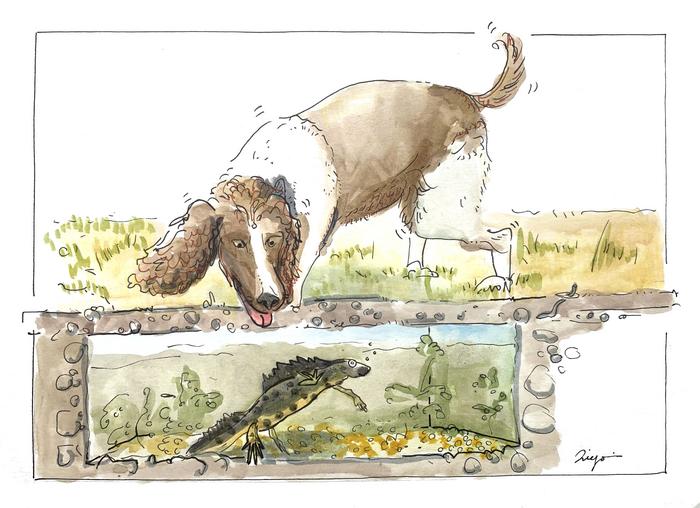A trained detection dog was highly accurate at finding great crested newts underground or at a distance, which might aid conservation efforts for this highly-endangered species, according to a study published June 7, 2023 in the open-access journal PLOS ONE by Nicola Jayne Glover from the University of Salford, UK, and colleagues.

Credit: Diego Perez-Lopez, PLOS, CC-BY 4.0 (https://creativecommons.org/licenses/by/4.0/)
A trained detection dog was highly accurate at finding great crested newts underground or at a distance, which might aid conservation efforts for this highly-endangered species, according to a study published June 7, 2023 in the open-access journal PLOS ONE by Nicola Jayne Glover from the University of Salford, UK, and colleagues.
The highly-endangered great crested newt (Triturus cristatus) is a species of special conservation concern across the UK and central and northern Europe. While much is known about the great crested newts’ aquatic life phase, comparatively little is known about their terrestrial life phase—which often takes place below ground and out of sight, in mammal burrows or rocky crevices. The newts are also difficult to detect on land, an issue when surveying ahead of construction projects. These factors limit the effectiveness of current conservation policies and practices for these newts. Detection dogs have been used successfully to find other elusive species in challenging environments, suggesting that detection dogs may also be effective in finding great crested newts during their terrestrial phase.
The authors used Freya, a six-year-old trained English springer spaniel, to investigate how environmental factors specific to great crested newts might affect their detectability. Freya was tested to see whether she could identify great crested newts at a range of channeled distances through pipes, and also tested to see how the soil substrate in which the newts were under (sandy versus clay soil, as well as substrates with vents to simulate mammal burrows) might affect detection.
Over sixteen trial runs, Freya was able to detect great crested newts across the entire distance range (a minimum of two meters away), with only two false positives early in the trials at the first run-through—an 87 percent success rate. She was also able to detect newts in both sandy and clay vented and unvented soils with high accuracy; over 128 trials, she demonstrated an 88 percent success rate, with the 12 percent of false indications generally false positives. She was significantly faster at detecting great crested newts in vented substrate, versus unvented substrate. Clay soil unvented treatments was also significantly faster and more accurate than sandy soil unvented treatments.
The authors note that other dogs would likely require significant training to achieve success rates as high as Freya, with accuracy also depending on the specifics of the detection site. Still, these results suggest that detection dogs could be very effective in locating great crested newts during their subterranean phase, which would be helpful from a research perspective as well as for conservation requirements.
The authors add: “This pioneering research shows how detection dogs can be a valuable addition to the current toolbox used to locate threatened amphibian species, particularly those using subterranean shelters. This study also highlights how soil type can have an influence on the accuracy and speed of detection.”
#####
In your coverage please use this URL to provide access to the freely available article in PLOS ONE: https://journals.plos.org/plosone/article?id=10.1371/journal.pone.0285084
Citation: Glover NJ, Wilson LE, Leedale A, Jehle R (2023) An experimental assessment of detection dog ability to locate great crested newts (Triturus cristatus) at distance and through soil. PLoS ONE 18(6): e0285084. https://doi.org/10.1371/journal.pone.0285084
Author Countries: UK
Funding: The authors received no specific funding for this work.
Journal
PLoS ONE
DOI
10.1371/journal.pone.0285084
Method of Research
Experimental study
Subject of Research
Animals
Article Title
An experimental assessment of detection dog ability to locate great crested newts (Triturus cristatus) at distance and through soil
Article Publication Date
7-Jun-2023
COI Statement
The authors have declared that no competing interests exist.




